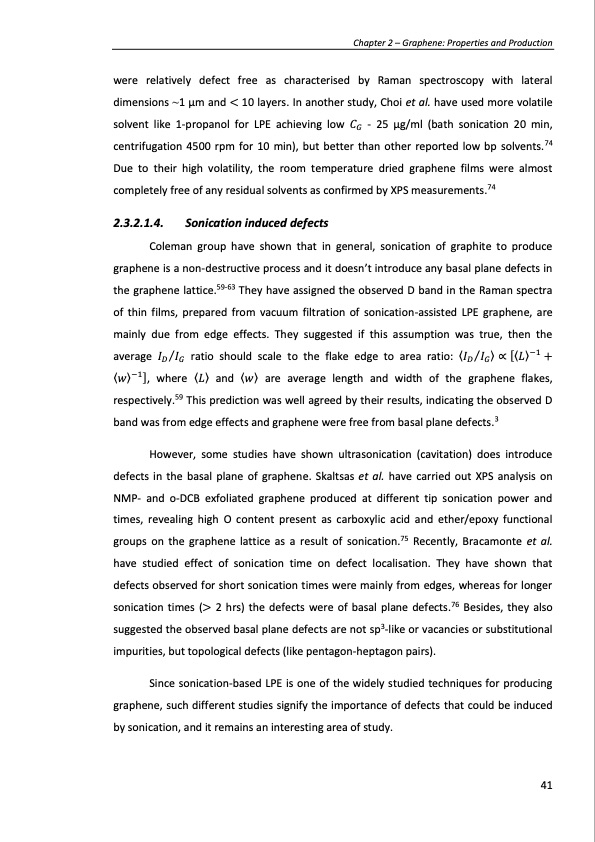
PDF Publication Title:
Text from PDF Page: 041
were relatively defect free as characterised by Raman spectroscopy with lateral dimensions ~1 μm and < 10 layers. In another study, Choi et al. have used more volatile solvent like 1-propanol for LPE achieving low 𝐶𝐺 - 25 μg/ml (bath sonication 20 min, centrifugation 4500 rpm for 10 min), but better than other reported low bp solvents.74 Due to their high volatility, the room temperature dried graphene films were almost completely free of any residual solvents as confirmed by XPS measurements.74 2.3.2.1.4. Sonication induced defects Coleman group have shown that in general, sonication of graphite to produce graphene is a non-destructive process and it doesn’t introduce any basal plane defects in the graphene lattice.59-63 They have assigned the observed D band in the Raman spectra of thin films, prepared from vacuum filtration of sonication-assisted LPE graphene, are mainly due from edge effects. They suggested if this assumption was true, then the average 𝐼𝐷 ⁄𝐼𝐺 ratio should scale to the flake edge to area ratio: 〈𝐼𝐷 ⁄𝐼𝐺 〉 ∝ [〈𝐿〉−1 + 〈𝑤〉−1], where 〈𝐿〉 and 〈𝑤〉 are average length and width of the graphene flakes, respectively.59 This prediction was well agreed by their results, indicating the observed D band was from edge effects and graphene were free from basal plane defects.3 However, some studies have shown ultrasonication (cavitation) does introduce defects in the basal plane of graphene. Skaltsas et al. have carried out XPS analysis on NMP- and o-DCB exfoliated graphene produced at different tip sonication power and times, revealing high O content present as carboxylic acid and ether/epoxy functional groups on the graphene lattice as a result of sonication.75 Recently, Bracamonte et al. have studied effect of sonication time on defect localisation. They have shown that defects observed for short sonication times were mainly from edges, whereas for longer sonication times (> 2 hrs) the defects were of basal plane defects.76 Besides, they also suggested the observed basal plane defects are not sp3-like or vacancies or substitutional impurities, but topological defects (like pentagon-heptagon pairs). Since sonication-based LPE is one of the widely studied techniques for producing graphene, such different studies signify the importance of defects that could be induced by sonication, and it remains an interesting area of study. Chapter 2 – Graphene: Properties and Production 41PDF Image | PRODUCTION AND APPLICATIONS OF GRAPHENE AND ITS COMPOSITES

PDF Search Title:
PRODUCTION AND APPLICATIONS OF GRAPHENE AND ITS COMPOSITESOriginal File Name Searched:
graphene-production-applications.PDFDIY PDF Search: Google It | Yahoo | Bing
Salgenx Redox Flow Battery Technology: Power up your energy storage game with Salgenx Salt Water Battery. With its advanced technology, the flow battery provides reliable, scalable, and sustainable energy storage for utility-scale projects. Upgrade to a Salgenx flow battery today and take control of your energy future.
| CONTACT TEL: 608-238-6001 Email: greg@infinityturbine.com | RSS | AMP |